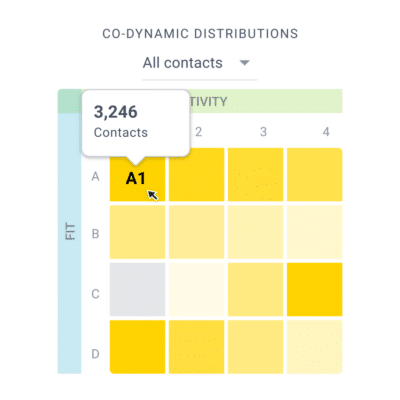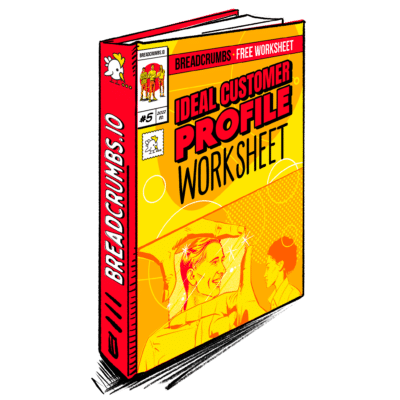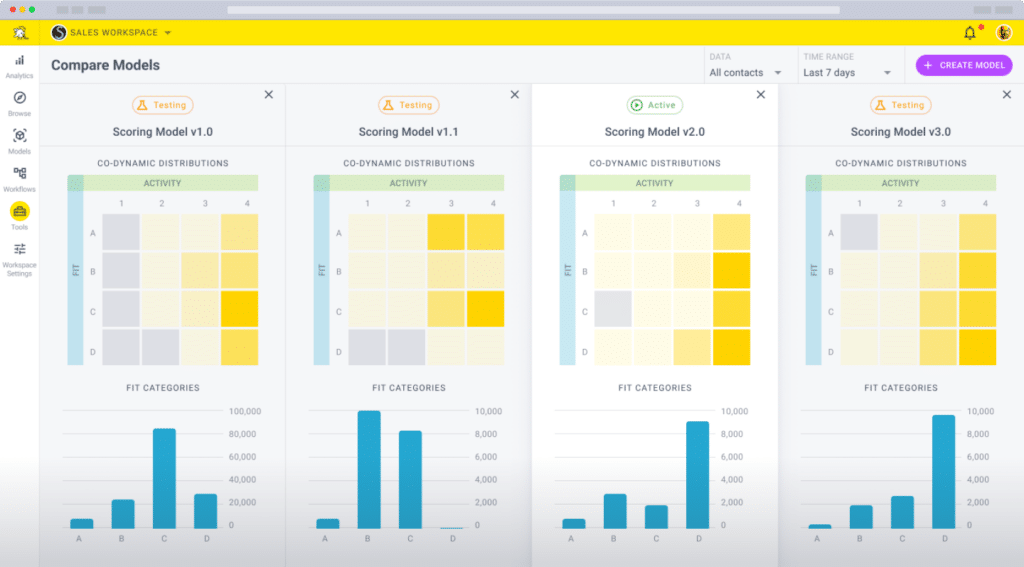We’ve talked about how to build a high-performing lead-scoring model, and we’ve gone over how to then implement that model. Today we’re going to talk about the five rules you need to effectively measure the impact of your lead scoring model.
You’ve hopefully created a killer lead-scoring model and put it into action, so it’s time for measurement and optimization. And spoiler alert: It’s not just about conversion rate.
Focusing exclusively on conversion rate is one of the most common errors we’ve seen while optimizing scoring models, and while it’s critical, it’s not the only thing that matters.
Your models need to optimize for conversions but also for Volume, Velocity, and Value, too, if you want to get a compounding impact that will push you most effectively to Revenue Acceleration.
The Five Rules to Measuring the Impact of Your Lead Scoring Model
There are five different rules you need to follow when assessing how much your scoring model is actually impacting your business—and make sure you follow all five!
1. Different Score = Different Conversion Rate
The first thing that you need to do is to assess whether or not different scores are actually driving different conversion rates.
When using Breadcrumbs, you can do that by validating that leads in different quadrants are behaving in materially different ways in downstream conversions. There should, in other words, be a fairly clear linear decline in conversion from A1 quadrants to D4 quadrants.

Validate that different cohorts behave in a materially different way when it comes to conversion downstream. You want to see a linear decline in conversion from As to Ds.
It’s essential to segment your leads and analyze who, in each cohort, is also converting at different stages of the sales funnel. A-rated leads should be converting at a higher rate than Bs, or at least converting for higher-value products. This will help you prioritize your leads and allocate your sales resources more effectively.
If your quadrants aren’t successfully indicating potential behavior with downstream conversions, it may be time to reassess the scoring model.
2. The Volume of High-Quality Leads Should Increase Over Time
With an effective lead scoring model in place, you should be seeing an increase in high-quality leads over time. Specifically, you want to be seeing 5-15% of scored contacts showing up in that top left quadrant, and you can adjust weighting through the slider bars for grades.
And as you better understand which leads are most likely to convert thanks to an increasingly-accurate scoring model, your understanding of your ideal customer profile (ICP) should also improve.

Ebook
Ideal Customer Profile (ICP) Worksheet
Learn how to create an Ideal Customer Profile and build a successful sales strategy with this Ideal Customer Profile (ICP) Worksheet.
This will make it easier for the marketing team and the sales team to get on the same page about who they want to attract, which should open the door to more high-quality leads over time.
High-quality leads should increase over time. You can also throttle the volume of leads passed to sales based on strategic needs.
Because of this, you need to perform an analysis of your top-scored leads on a quarterly basis. You want to review the following:
- Where they came from
- What qualities they have in common
- What paths to conversion they followed
- Which channels effectively generated more of them
Once you can understand the formula, you can double down on attracting these leads.
If needed, you can also throttle the volume of leads passed to the sales team by adjusting the definition of “A” in your scoring model. Breadcrumbs will tell you in real time how every change will impact your volumes so you can always make an informed decision about what changes you want to make and when.

And as a quick note: If you want to better define your ICP immediately, check out Reveal.
3. Velocity Matters
Velocity matters just as much as volume, so you need to monitor it closely.
With a strong lead scoring model, you should be able to see your time-to-close decrease as your team is better able to identify high-intent leads and move them through the sales funnel.
Leads become customers quickly, especially as your team is able to size up different types of leads and what products or approaches work most effectively for you.
Lead scoring models should generate high velocity of lead-to-customer conversion times, shortening the amount of time it takes for leads to become customers.
In consultative sales, you’re going to want to see an increased ClosedWon-to-ClosedLost ratio, meaning you’re closing more deals than you’re losing. You want to tighten that gap, and a more effective buyer’s journey can help with that.
Keep in mind that you want to continually review your model over time, especially as your velocity increases. You want to ensure that your A1s are not only the top-converting leads for your business, but also those that will close in the shortest time. That’s where that quarterly analysis comes into play; re-reviewing your leads’ closing time can be essential.
-
Lead Scoring vs Lead Nurturing: 7 Differences to Maximize Your Sales Funnel
Read more: Lead Scoring vs Lead Nurturing: 7 Differences to Maximize Your Sales FunnelManaging leads effectively means prospects move through the funnel efficiently, resulting in more conversions and…
4. Always Measure Value
Some leads will close on a $100-a-month SaaS package. Others will close on a $2,000-a-month SaaS package. While both are great, they are not equal.
Similarly, some clients may retain significantly longer than others, which impacts customer lifetime value (LTV) along the way.
It’s essential to assess the value of a deal when considering how effective your scoring models are. Your models should reflect the fact that high quadrant leads are more likely to close at a higher level, in addition to closing faster and more often.
When it comes to value, the better the fit is, the more likely it is you can sell at a higher price point. Validate that different cohorts of contacts behave differently.
The better the fit of a lead, the more likely you can sell at a higher price point. This is because leads that are a better fit for your product or service are more likely to see the value in what you’re offering and be willing to pay a premium.
It can be tricky trying to tie all of these qualities together, so you want to make sure that different quadrants of contacts are behaving as you’d expect based on your scoring model. You may find that specific segments are more price-sensitive than others; B2 might be a great demographic and activity fit but take much longer to convert than anyone in your upper A quadrants, for example.
Once you know this, however, you can adapt your sales strategy accordingly to account for value and potential hesitancy at different price points.
5. Conversion x Velocity x Value x Volume = 🚀📈
Each trait we’ve discussed so far—conversion, velocity, value, and volume—is useful to assess on its own, but ensuring that your scoring models are actively helping you increase them all is the path to success.
A good scoring model will impact any single metric in a positive way, but only a great scoring model will impact them all at the same time. And ideally, if you’re ready to scale your business in a big way, you’ll be able to impact all the metrics.
Who doesn’t want more leads that convert more often at a higher value and in shorter time?
That’s the dream, right?
A good scoring model will impact any of the key metrics of conversion, velocity, volume, or value—but a great one will impact all four.
And don’t worry: When you’re getting started, it’s normal (and sometimes recommended) to focus on optimizing a single metric at a time. This can help you make sure that each change you’re making is impacting your pipeline positively, moving the specific objective in the right direction without crashing anything else around it.
Once you’ve tackled one objective, however, you can move on to the next. As you do this during the optimization stage of implementing your lead scoring model, you’ll often find significant momentum working to improve more objectives at once.
This is one reason why A/B testing different scoring models was built into our system from day one. It’s essential to see what changes impact your scoring models and how, and this feature is invaluable when you’re at the optimization stage.

Measure the Impact of Your Lead Scoring Model: Final Thoughts
Lead scoring models are invaluable when you want to sell more, but the definition of “more” varies. Do you want to sell to more customers? Sell faster? Sell at a higher volume, or a higher value?
Optimizing your lead scoring models should help you do all the above, especially since it can give you essential information that helps sales and marketing. The quality and quantity of relevant leads will increase, and ideally, sales will, too.
The more your model is able to identify contacts that are likely to close in the shortest timeframe possible and at the highest possible deal, the more your revenue growth can accelerate.
Ready to get results like this and unlock unprecedented revenue growth? We can help. Book your free demo to learn more about how we can help set you up for success.



